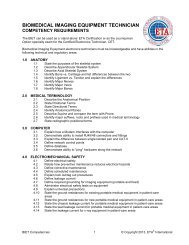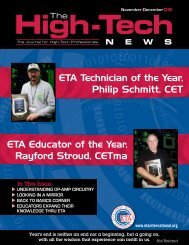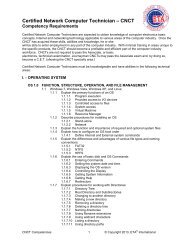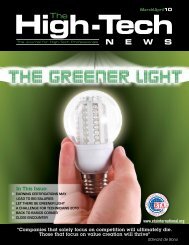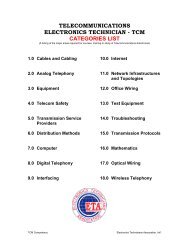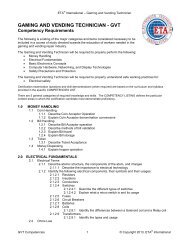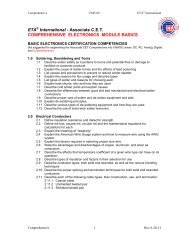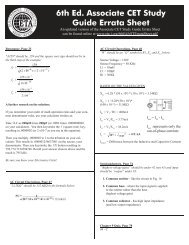fiber optics technician â outside plant (fot-osp) - ETA International
fiber optics technician â outside plant (fot-osp) - ETA International
fiber optics technician â outside plant (fot-osp) - ETA International
Create successful ePaper yourself
Turn your PDF publications into a flip-book with our unique Google optimized e-Paper software.
Fiber Optics Technician – Outside Plant Knowledge Competencies7.0 CONNECTORS7.1 Identify standard <strong>fiber</strong> optic cable connector types7.2 Explain intrinsic factors applicable to losses in <strong>fiber</strong> connectors7.3 Explain extrinsic factors that cause attenuation in a <strong>fiber</strong> optic connection7.4 Describe how interconnection losses can be identified using common measuring equipment7.5 Explain how reflections can be identified in a completed cable link7.6 Describe a PC polish7.7 Describe a UPC polish7.8 Describe an APC polish7.9 Describe how and where pigtails are used in <strong>fiber</strong> optic cabling systems7.10 List steps taken to properly perform a visual inspection of an optical plug (connector)7.11 Describe proper cleaning of a single-mode plug and sleeve7.12 Describe contaminated or damaged connector ferrules7.13 Name common contaminants found in <strong>fiber</strong> cabling systems7.14 Describe common types and causes of <strong>fiber</strong> damage at the ferrule7.15 Describe a small form factor (SFF) connector as used in <strong>fiber</strong> optic transmission systems7.16 Describe the type of bonding techniques optimized for FTTx single <strong>fiber</strong> terminations7.17 Describe what an array connector is and its common applications8.0 PASSIVE COMPONENTS8.1 Explain the uses and benefits as well as disadvantages of using <strong>fiber</strong> optic signal splitters8.2 Describe where optical splitters are used in FTTx applications8.3 Explain wavelength division multiplexing (WDM)8.4 Explain how WDM is used in FTTH/PON systems8.5 Explain the differences between WDM and DWDM8.6 Explain the differences between WDM and CWDM8.7 Describe a wavelength independent (WIC) coupler and its characteristics8.8 Describe how an insertion loss test is conducted for optical splitters8.9 List the theoretical attenuation values for 1x2, 1x4, 1x16 and 1x32 splitters8.10 Explain how to test and compare measured versus theoretical losses of splitters8.11 Explain why an optical attenuator may be required in a <strong>fiber</strong> <strong>optics</strong> system9.0 TYPES OF SPLICING9.1 Explain the differences between intrinsic factors and extrinsic factors when splicing optical <strong>fiber</strong>s9.2 List extrinsic factors important in <strong>fiber</strong> splicing9.3 Describe correct <strong>fiber</strong> cable preparation9.4 Explain the purpose of index matching gel and where it is used9.5 Explain the benefit of index matching fluids9.6 Describe Telcordia GR-20 performance specification standards for mechanical and fusion splices9.7 Explain the purposes of the splice closure9.8 Describe the correct cleaving operation for a <strong>fiber</strong> optic splice9.9 Explain the purpose and the correct method of applying a splice protector9.10 Describe splice trays and their usage9.10.1 Identify the proper color code sequence for splice tray management9.11 Explain the role and benefits of pigtail splices in a single-mode system9.12 List the two coatings used in single-mode pigtail splicing9.13 Explain where mechanical splices are used in single-mode systems10.0 CABLE INSTALLATION10.1 Define ‘dynamic tensile loading’ of a <strong>fiber</strong> optic cable10.2 Explain ‘static tensile loading’ and compare with dynamic tensile loading10.3 Compare the dynamic bend radius minimums for common OSP <strong>fiber</strong> cables10.4 Describe the effects of exceeding minimum bend radius limitations10.5 Explain when and where bonding to ground is required10.6 Describe a pulling grip and explain its usage10.7 Describe where conduit should be installed to protect <strong>fiber</strong> optic cables10.8 Describe the National Electrical Code (NEC ® ) Article 770 rules pertaining to cabling10.9 Describe the role of the National Electric Safety Code (NESC) for aerial and buried installationsFOT-OSP Competencies 3 © Copyright 2014, <strong>ETA</strong> ® <strong>International</strong>



